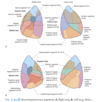Lungs Flashcards
Which lung is larger
Right lung because the middle mediastinum (containing the heart) bulges more to the left than to the right

Where does the apex sit
Projects above rib I and into the root of the neck
Anterior border
Sharp
Inferior border
Sharp
Posterior border
Smooth and rounded
Roots and hila of the lungs

What does the pulmonary ligament (thin-like fold of pleura) do
Stabilises the position of the inferior lobe and may also accommodate the down and up translocation of structures in the root during breathing
Name the nerves that pass immediately posterior and anterior to the roots of the lungs
- Vagus nerves pass posterior
- Phrenic nerves pass anterior
Structures located within each root and located in the hilum
- Pulmonary artery (superior)
- 2 pulmonary veins (most anterior and inferior)
- A main bronchus (posterior)
- Bronchial vessels
- Nerves
- Lymphatics
On the right side, where does the lobar bronchus to the superior lobe branch from
The main bronchus in the root
On the left side, where does the lobar bronchus to the superior lobe branch from
Branches within the lung itself
Is superior to the pulmonary artery
How many lobes does the right lung have
3 lobes => 2 fissures

Position of the oblique fissure on a patient
Begins at the SP of T4, crosses the 5th IC laterally and then follows the contour of rib 6 anteriorly
Position of the horizontal fissure
Follows the 4th IC space from the sternum until it meets the oblique fissure as it crosses rib 5
What is the superior lobe in contact with
Upper part of the anterolateral wall
Where does the surface of the middle lobe lie
Mainly adjacent to the lower anterior and lateral wall
What is the costal surface of the inferior lobe in contact with
Posterior and inferior walls
Structures adjacent to the medial surface of the right lung
- Heart
- IVC
- SVC
- Azygos vein
- Oesophagus
- right subclavian artery and vein arch over and are related to the superior lobe of the right lung (as they pass over the dome of the cervical pleura into the axilla)
Structure of left lung
Oblique fissure is more oblique

Position of oblique fissure (left lung)
Begins between SP of T3 and T4, crosses the 5th interspace laterally and follows the contour of rib 6 anteriorly
LEFT LUNG
Position of superior lobe
It’s in contact with the upper part of the anterolateral wall
LEFT LUNG
What is the costal surface of the inferior lobe in contact with
Posterior and inferior walls
Extension of the anterior border of the lower part of the superior lobe
Lingula of left lung projects over heart bulge
What does the medial surface of the left lung lie adjacent to
- Heart
- Aortic arch
- Thoracic aorta
- Oesophagus
- The left subclavian artery and vein arch over and are related to the superior lobe of the left lung as they pass over the dome of the cervical pleura and into the axilla







